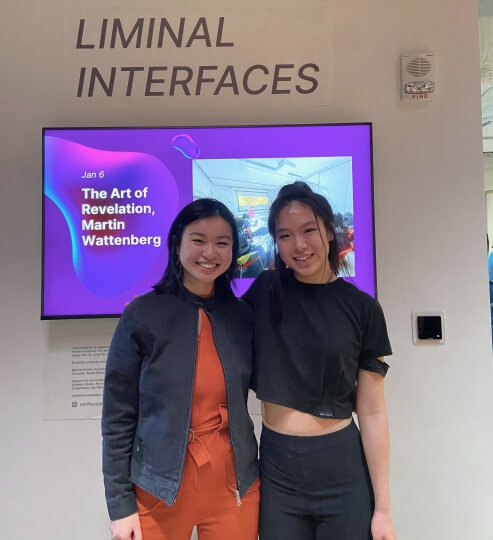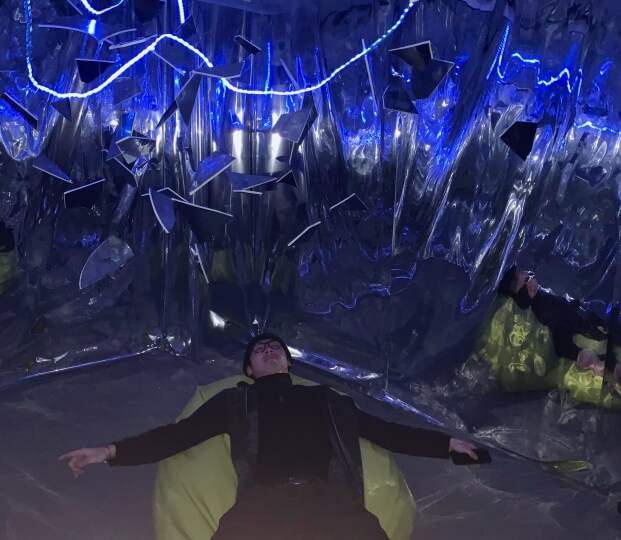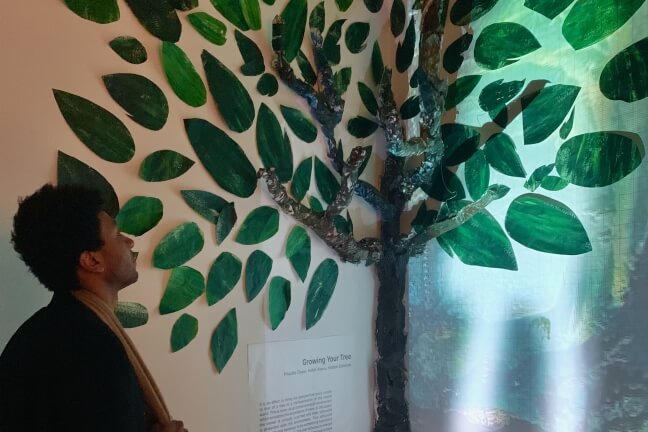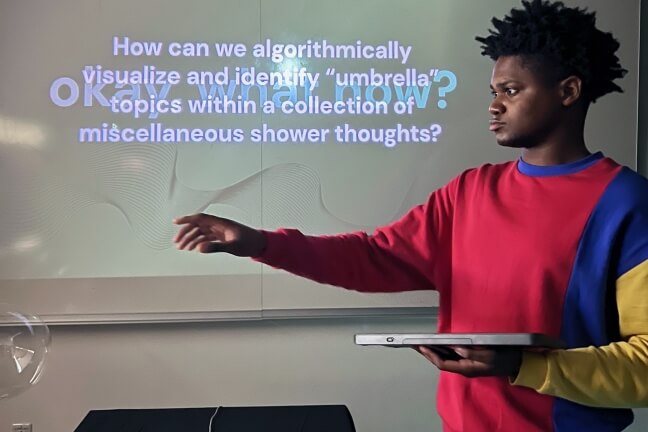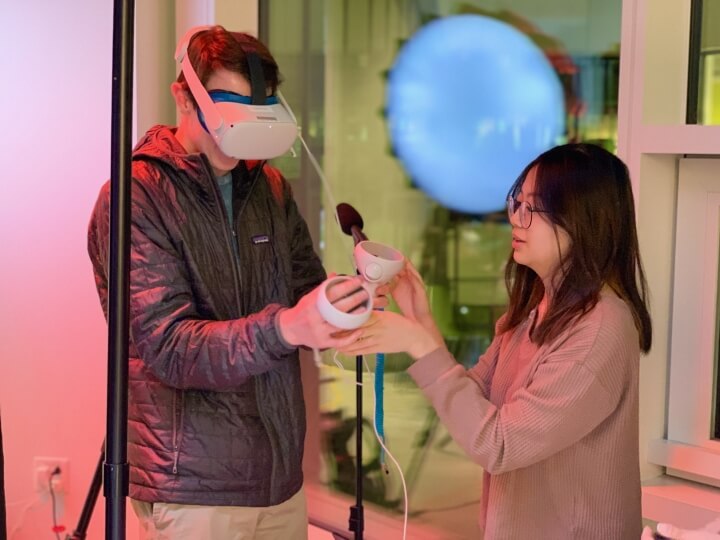News
Conflux cofounders Peggy Yin and Alice Cai (Aida Baradari)
Alice Cai and Peggy Yin couldn’t find the community they were looking for at Harvard. Both were interested in the intersection of technology and art, though they came at it from slightly different angles.
“My background was in writing and storytelling, and I was interested in computation,” said Cai, a second-year student applying for special concentration called “Human Augmentation” at the Harvard John A. Paulson School of Engineering and Applied Sciences (SEAS).
“I was interested in finding a way to combine my love for music and the humanities with my interest in science, and I have always enjoyed community building,“ said Yin, a second-year pursuing a double concentration in computational neuroscience and history of art and architecture. “We couldn’t find a community to explore that on campus, but once we met each other, we decided to start one,” said Cai.
That community became Conflux, a new student organization. The group recently finished its winter session residency with “Liminal Interfaces,” a series of interactive multimedia art installations at the Science and Engineering Complex.
“At the beginning of this residency we asked everyone what they were in between, and through that we realized this entire exhibit is about being between those two things, art and tech,” said Yin. “How they combine and form one experience that leaves you feeling differently is where the concept of ‘liminal interfaces’ was born.”
Each exhibit in “Liminal Spaces” combined technology and art in an interactive, immersive experience. In “Inner Piece,” visitors walked around a room coated in mylar to create a series of reflected surfaces. More reflective shards were suspended from the middle of the room, and the only light source was a string of LED lights which flashed and moved according to a portable heart rate monitor.
Julian Li insider "Inner Piece," the installation he co-created with Liya Jin and Sera McDonald. (Holden Edmonds)
“We try to create a very multisensory experience focused on the concepts of ‘reflection’ and the liminal space between viewing an external reflection of yourself and the internal reflection that takes place,” said Liya Jin, a fourth-year computer science (CS) student. Added Julian Li, who designed the exhibit along with Jin and Sera McDonald, “In the day-to-day world, often we’re distracted by all these sensory things around us. You don’t often get a chance to have those distractions removed and have the environment around you be something that encourages you to turn your attention inward. The environment here is responsive to your body and movement.”
Li and Jin were both drawn to Conflux because its integrated approach to art and technology offered something they were missing. Li, a neuroscience and architecture student, hadn’t had many creative arts opportunities in his coursework, while Jin wanted a more holistic approach to art and technology that she couldn’t find in her CS classes. Many of the residents joined Conflux for similar reasons.
“Conflux really focuses on design and experience,” said Karen Li, a third-year studying CS and psychology. “A lot of my past experiences were very software-oriented, where I was building programs on my laptop. This is an installation. It’s a lot more cohesive, more about how you feel when you view this data visualization. It’s not just the technical side.”
Li co-created “Shower Thoughts” with fourth-year electrical engineering student Ricky Williams. They collected a large number of random thoughts drawn from both visitors and internet forums, then grouped them into an interconnected web of thought bubbles projected onto a wall. Visitors could then manipulate the web by holding their arms out in front of them.
“The biggest thing it emphasizes is the border between directed and spontaneous thought,” Williams said. “When you daydream, it’s a liminal space between where you are and what you’re thinking about.”
An attendee interacts with "Growing Your Tree," by Priscilla Cheav, Holden Edmonds and Kidist Alemu. (Matt Goisman/SEAS)
Ricky Williams and "Shower Thoughts" (Karen Li)
“Liminal Interfaces” was supported by undergraduate student experiences funding earmarked for SEAS-affiliated student organizations via the Teaching and Learning group, as well as from the Office for the Arts at Harvard. Other exhibits included “Edge of an Atlas,” by Taylor Fang, a poem displayed as a series of lines across the ceiling; “Passage of Possibility,” a painting by Kaitlyn Zhou and Alina Yu that turns three-dimensional when viewed using an augmented reality application; and “Growing Your Tree,” an interactive display by Priscilla Cheav, Holden Edmonds and Kidist Alemu. In “Growing Your Tree,” visitors entered a room with both a physical tree and a forest projected onto a wall. A camera in the installation captured the silhouette of the visitor and superimposed it onto the forest projection, causing a new tree to blossom, grow to maturity and then wither.
“The liminal space that we’re looking at is between the forest and the man-made world, and also between life and death,” said Alemu, a fourth-year CS student. “We’re looking at the growth of trees in parallel with the growth of human beings. But with growth also comes death, so we want our participants to interact with that and grapple with those concepts.”
Alina Yu, right, helps an attendee with his virtual reality headset for the "Recognition" installation. (Matt Goisman/SEAS)
In “Recognition,” by Yu, AhnPhu Nguyen and Kassandra Rodriguez-Acosta, participants’ faces and voices were recorded and uploaded into a virtual reality environment. Those features were then distorted as they descended through a horror-themed virtual graphic novel.
“It’s about identity, the process of finding and traversing all the different versions of yourself,” said Yu, a second-year CS and government student. “You get cloned into the exhibit, and we make a few different versions of you. So, as you transcend down the virtual staircase, you come face to face with all the different versions of yourself.”
This isn’t Conflux’s first exhibition at the SEC. Right before Halloween, the group teamed up with hAR/VRd to create “Nervous Network,” a group wearable tech costume which combined virtual reality headsets, LED light strings and heart rate monitors to create a colorful visual representation of human fear.
“Liminal Interfaces” and “Nervous Network” are exactly the kind of art-technology intersection that Conflux plans to keep exploring in the coming months and hopefully years.
“Where we are now with this residency, it’s not just about collaborating between people who think differently, but how we create a language, discipline and art that truly embodies both art and technology,” Yin said. “I’m super excited about the future of Conflux, one where it’s about convergence and discovery.”
Cutting-edge science delivered direct to your inbox.
Join the Harvard SEAS mailing list.
Press Contact
Matt Goisman | mgoisman@g.harvard.edu
